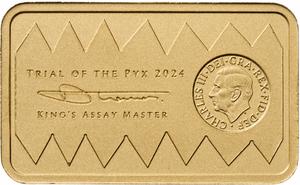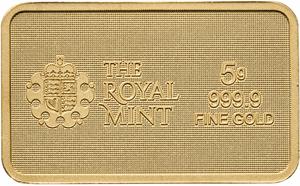The Royal Mint of the United Kingdom, which makes the country's circulating coinage, is also very active in the bullion coinage space and issues many bullion coins which are legal tender.
Additionally, it also makes bullion which is not legal tender and is targeted at investors and not at coin collectors - such as this one.
This gold bar is part of a limited edition which is the first in the history of the Royal Mint, as it was made from metal used in the Trial of the Pyx.
The Trial of the Pyx is a judicial ceremony in the United Kingdom to ensure that newly minted coins from the Royal Mint conform to their required dimensional and fineness specifications. Although coin quality is now tested throughout the year under laboratory conditions, the event has become an annual historic tradition. Each year, thousands of coins are put on trial, consisting of both those struck for circulation and non-circulating commemorative coins.
First held in the 12th century, the event takes place in the hall of the Worshipful Company of Goldsmiths in London, where the Deputy Master of the Mint (Chief Executive of the Royal Mint) is in effect put on trial before a High Court judge as metallurgical assayers and selected leaders from the financial world sample coins from the mint's output. The boxes in which coins are stored form the ceremony's namesake: the word pyx derives from the Greek πυξίς, pyxis meaning "wooden box".
Coins to be tested are drawn from the regular production of the Royal Mint. The Deputy Master of the Mint must, throughout the year, randomly select several thousand sample coins and place them aside for the Trial. These must be in a certain fixed proportion to the number of coins produced. For example, for every 5,000 bimetallic coins issued, one must be set aside, whereas for silver Maundy money the proportion is one in 150.
The jury is composed of at least six assayers from the Company of Goldsmiths. They have two months to test the provided coins, and decide whether they have been properly minted. Criteria are given for diameter, chemical composition and weight for each class of coinage. Sitting along a table, the jurors are handed packets of up to 50 coins. Each juror selects one coin from the pile, places it in a copper bowl and it is then sent to be assayed. At the company's assay office, the coins which were placed in the copper bowls are melted down and formed into plates where their fineness and weight can be compared against a corresponding trial plate which acts as a benchmark. Others are subjected to not so destructive testing After three months of testing, a ceremony presided over by the King's Remembrancer is held, when the final verdict is given.
In 2025, for the first time, the Royal Mint re-used the metal from the melted coin to strike these bars; they are dated 2024, as they are made from coins used in the 2024 trial. These bars are also the first to carry the portrait and legend of the monarch on a bullion product and not a legal tender coin. | 




 Buy this online from Royal Mint
Buy this online from Royal Mint
 Search for United Kingdom: Gold Five Grams Bar 2024 Trial of the Pyx on eBay
Search for United Kingdom: Gold Five Grams Bar 2024 Trial of the Pyx on eBay 

